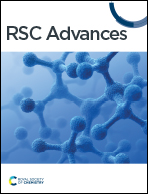Fe-modified NASICON-type Na3V2(PO4)3 as a cathode material for sodium ion batteries
Abstract
The sol–gel method is used to synthesize a new compound called Na3Fe0.8V1.2(PO4)3/C (NFVP/C), which has a crystal structure and belongs to the NASICON-type family. The dimensions of NFVP's unit cell are a = 8.717 (1) Å, c = 21.84 (1) Å, and V = 1437.27 (0) Å3. The Na‖NFVP/C battery provides a discharge potential of 3.43 V compared to Na+/Na, an intriguing rate capability of 76.2 mA h g−1 at 40C, and maintains an impressive capacity of 97.8% after 500 cycles at 5C. The excellent efficiency of Na3Fe0.8V1.2(PO4)3/C can be ascribed to its elevated Na+ conductivity and reduced energy barrier for sodium-ion diffusion. The NASICON-type Na3Fe0.8V1.2(PO4)3/C is a promising material for sodium-ion batteries.



 Please wait while we load your content...
Please wait while we load your content...